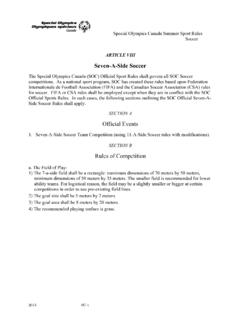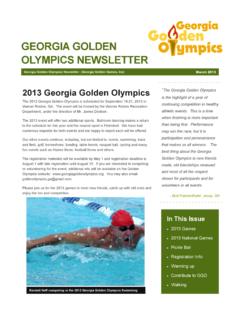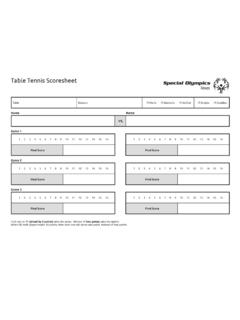Transcription of CONCUSSION AWARENESS AND SAFETY RECOGNITION …
1 CONCUSSION AWARENESS AND SAFETY RECOGNITION policy Objective It is special Olympics intent to take steps to help ensure the health and SAFETY of all special Olympics participants. All special Olympics participants should remember that SAFETY comes first and should take reasonable steps to help minimize the risks for CONCUSSION or other serious brain injuries. Defining a CONCUSSION A CONCUSSION is defined by the Centers for Disease Control as a type of traumatic brain injury caused by a bump, blow, or jolt to the head as well as serial, cumulative hits to the head. Concussions can also occur from a blow to the body that causes the head and brain to move quickly back and forth causing the brain to bounce around or twist within the skull. Although concussions are usually not life-threatening, their effects can be serious and therefore proper attention must be paid to individuals suspected of sustaining a CONCUSSION .
2 Suspected or Confirmed CONCUSSION Effective January 1, 2015, a participant who is suspected of sustaining a CONCUSSION in a practice, game or competition shall be removed from practice, play or competition at that time. If a qualified medical professional is available on-site to render an evaluation, that person shall have final authority as to whether or not a CONCUSSION is suspected. If applicable, the participant s parent or guardian should be made aware that the participant is suspected of sustaining a CONCUSSION . Return to Play A participant who has been removed from practice, play or competition due to a suspected CONCUSSION may not participate in special Olympics sports activities until either of the following occurs (i) at least seven (7) consecutive days have passed since the participant was removed from play and a currently licensed, qualified medical professional provides written clearance for the participant to return to practice, play and competition or (ii) a currently licensed, qualified medical professional determines that the participant did not suffer a CONCUSSION and provides written clearance for the participant to return to practice play immediately.
3 Written clearance in either of the scenarios above shall become a permanent record. Required Training and Timeline All Coaches are required to complete one of the following CONCUSSION AWARENESS training courses: The Center for Disease Control s Heads-Up CONCUSSION in Youth Sports training course, which is available at Certificate of completion must be submitted to the state Program. National Federation of State High School Associations CONCUSSION in Sports training course which is available at (Many State Athletic Associations require their high school coaches to complete this course.) Any CONCUSSION AWARENESS training other than the above-referenced courses must be approved by SOI. For Coaches registering for the first time on or after January 1, 2015, confirmation of such training must be provided to the Program prior to the individual beginning volunteer duties.
4 For Coaches registered prior to December 31, 2014, confirmation of such training must be provided to the Program no later than December 31, 2015. Any Program that is unable to meet this deadline may request a waiver from SOI by providing the reason for requesting the waiver and a plan for implementing the coaches training requirement to Jocelyn Starzak Programs must implement a system for tracking completion of the CONCUSSION AWARENESS training by Coaches. Frequency of Training CONCUSSION AWARENESS training must be completed by all Coaches at least once every three years. Communication with Parents and Guardians Programs are required to communicate in writing to all participants and/or parents/guardians, the CONCUSSION AWARENESS and SAFETY RECOGNITION program, as outlined in the Suspected or Confirmed CONCUSSION and Return to Play sections of this policy .
5 The Centers for Disease Control website provides additional resources relative to concussions that may be of interest to participants and their families. FREQUENTLY ASKED QUESTIONS 1. What is the recommended approach for communicating in writing the CONCUSSION AWARENESS and SAFETY RECOGNITION program to participants/parents/guardians? It is recommended that Programs provide the CONCUSSION AWARENESS and SAFETY RECOGNITION program with the athlete medical at least once every three years and also periodically distribute via newsletters, website, etc. 2. How often is the CDC training required? After the initial training is completed (as outlined in the policy ), all coaches must complete the training and provide confirmation of such training to their Program at least once every three years. Frequency of training is consistent with the requirements for coach s certification, volunteer screening and Protective Behaviors training so that the training can be incorporated into the current tracking processes.
6 3. How should parents/guardians be notified of a suspected CONCUSSION ? The Center for Disease Control s website includes several tools that can be provided to parents/guardians of a participant with a suspected CONCUSSION . It will also be important to share with the parent/guardian next steps relative to the participant s return to play, as outlined in the policy . 4. Is my Program subject to State law requirements? At this time, most States have laws addressing concussions. The requirements of the laws of each State can vary significantly, so each Program should consult its legal counsel to ensure compliance with local laws. In addition, the following website provides an overview of CONCUSSION laws in each state: #1. This website should not replace qualified counsel, but can be used as an initial resource. 5. Why are coaches for non-contact sports required to complete CONCUSSION AWARENESS training?
7 Although concussions may be more likely to occur in contact sports, concussions can occur as a result of any organized or unorganized recreational activity, and therefore it is important that all coaches participate in CONCUSSION AWARENESS training. 6. Why do special Olympics Return to Play requirements as outlined in the CONCUSSION AWARENESS and SAFETY RECOGNITION policy differ from the guidelines provided via the CONCUSSION training courses? The return to play guidelines described in some of the CONCUSSION training courses require gradually re-introducing strenuous physical activity over the course of several training sessions for those who have suffered concussions. Because special Olympics practices/activities do not occur on a daily basis as is often the case for interscholastic sports training, a similar type of return to play could be difficult to administer and could require a long period of time before an athlete is able to fully participate in special Olympics activities.
8 The Return to Play protocol included in the special Olympics CONCUSSION AWARENESS policy incorporates the RMITF s and MAC s careful consideration of the most appropriate Return to Play protocol for special Olympics athletes/activities. 7. There are multiple CDC Head s Up trainings. Which CDC Head s Up training should special Olympics coaches take? The policy requires the Heads-Up CONCUSSION in Youth Sports training course, which is available at The CDC website includes other resources/tools for parents, clinicians and school staff that can be used, as needed. 8. What is the procedure for tracking coach completion of CONCUSSION training? Each Program must implement its own policies and procedures for tracking completion of the CONCUSSION training. o Center for Disease Control (CDC) Training The coach will receive a certificate at the end of the training course that can be printed and sent to the special Olympics Program.
9 Alternatively, for those Programs that wish to track the training in a manner similar to protective behaviors, SOI is in the process of developing a quiz that will be on the SOI website and will direct coaches to complete the quiz after taking the CDC training. Programs will then be notified by SONA of coaches who complete the quiz. o National Federation of State High School Association Training - SONA will provide Programs with a quarterly list of individuals who have taken the National Federation of State High School Associations CONCUSSION in Sports training course (available at ) and have listed special Olympics under school/organization when completing the profile information. Additionally, Programs may look up coaches using the coach search feature or distribute courses to each coach and track each coach s progress as administrative.
10 For more information about these alternative tracking features, please contact Annette Lynch or Brian Quinn 9. Why are coaches required to complete the training only once every 3 years? Programs may require coaches to complete the training more frequently. However, the 3-year cycle was chosen to coincide with the Protective Behaviors and Coaches Certification requirements. 10. What if a coach does not complete the required training? The CONCUSSION AWARENESS and SAFETY RECOGNITION policy outlines the training requirements for all coaches. Each Program should develop its own process relative to the implementation, tracking and enforcement of the CONCUSSION AWARENESS and SAFETY RECOGNITION policy to ensure compliance with the policy . 11. Does the CONCUSSION AWARENESS and SAFETY RECOGNITION policy apply to Unified Partners? Yes, Unified Partners who are suspected of having a CONCUSSION are subject to the Return to Play guidelines as outlined in the policy .







